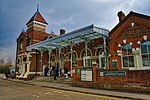St John's School, Leatherhead
1851 establishments in EnglandBoarding schools in SurreyCricket grounds in SurreyEducational institutions established in 1851Leatherhead ... and 6 more
Member schools of the Headmasters' and Headmistresses' ConferencePeople educated at St John's School, LeatherheadPrivate schools in SurreySports venues completed in 1879Surrey County Cricket Club groundsUse British English from August 2013

St John's School in Leatherhead, Surrey is a fully co-educational Private school for pupils aged 11 to 18. The school offers day, weekly and flexible boarding for approximately 800 pupils.St John's was founded in 1851 to educate the sons of the clergy, and was moved from St John's Wood, London to its current site in Surrey in 1872. Set in 50 acres (20 ha), the school's site is a mixture of old and new, with mid-Victorian architecture complemented by a Science Centre, and modern classroom blocks and boarding houses.
Excerpt from the Wikipedia article St John's School, Leatherhead (License: CC BY-SA 3.0, Authors, Images).St John's School, Leatherhead
Garlands Road, Mole Valley
Geographical coordinates (GPS) Address Phone number Website External links Nearby Places Show on map
Geographical coordinates (GPS)
| Latitude | Longitude |
|---|---|
| N 51.297 ° | E -0.323 ° |
Address
St John's School
Garlands Road
KT22 8SP Mole Valley
England, United Kingdom
Open on Google Maps







